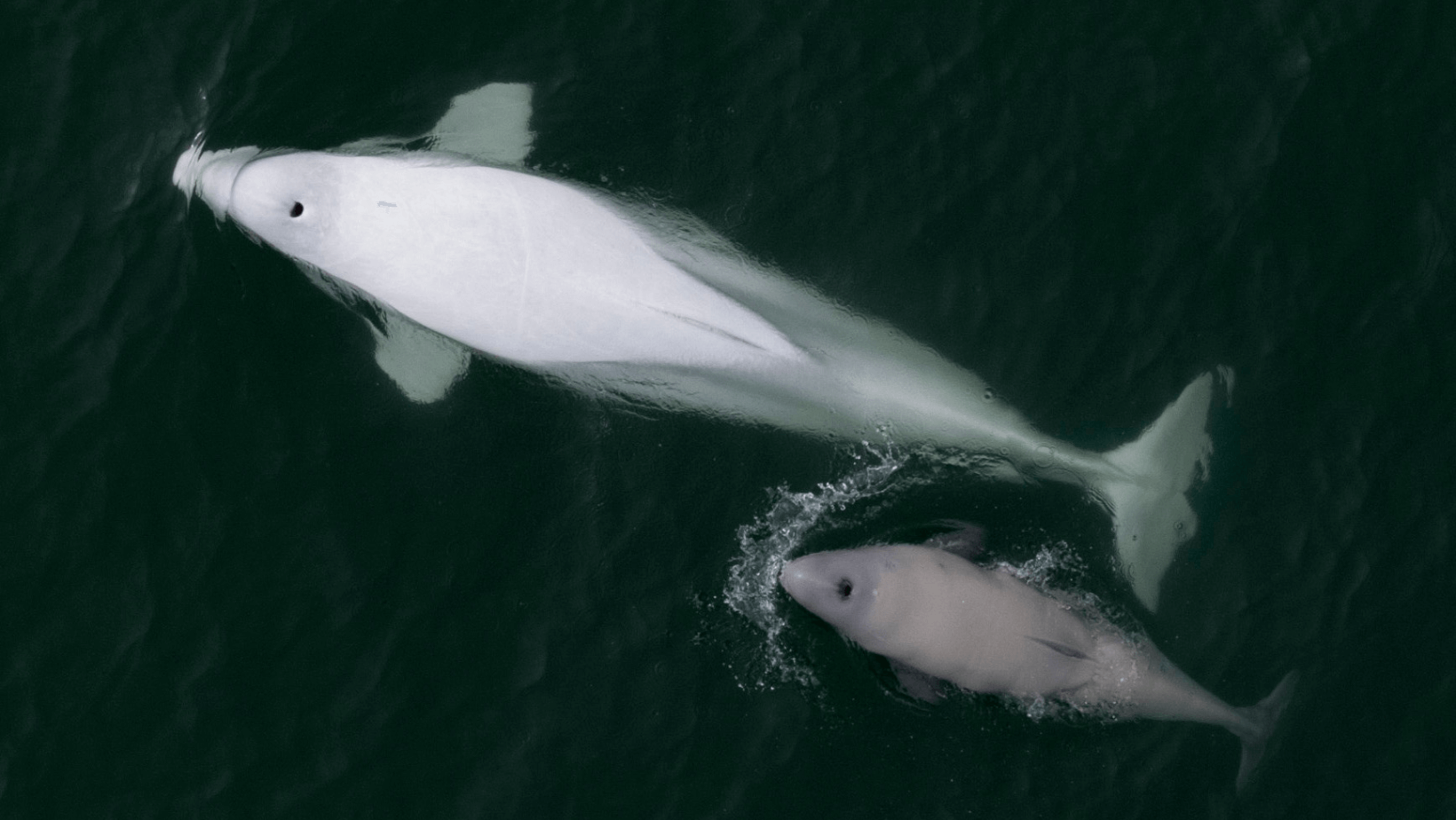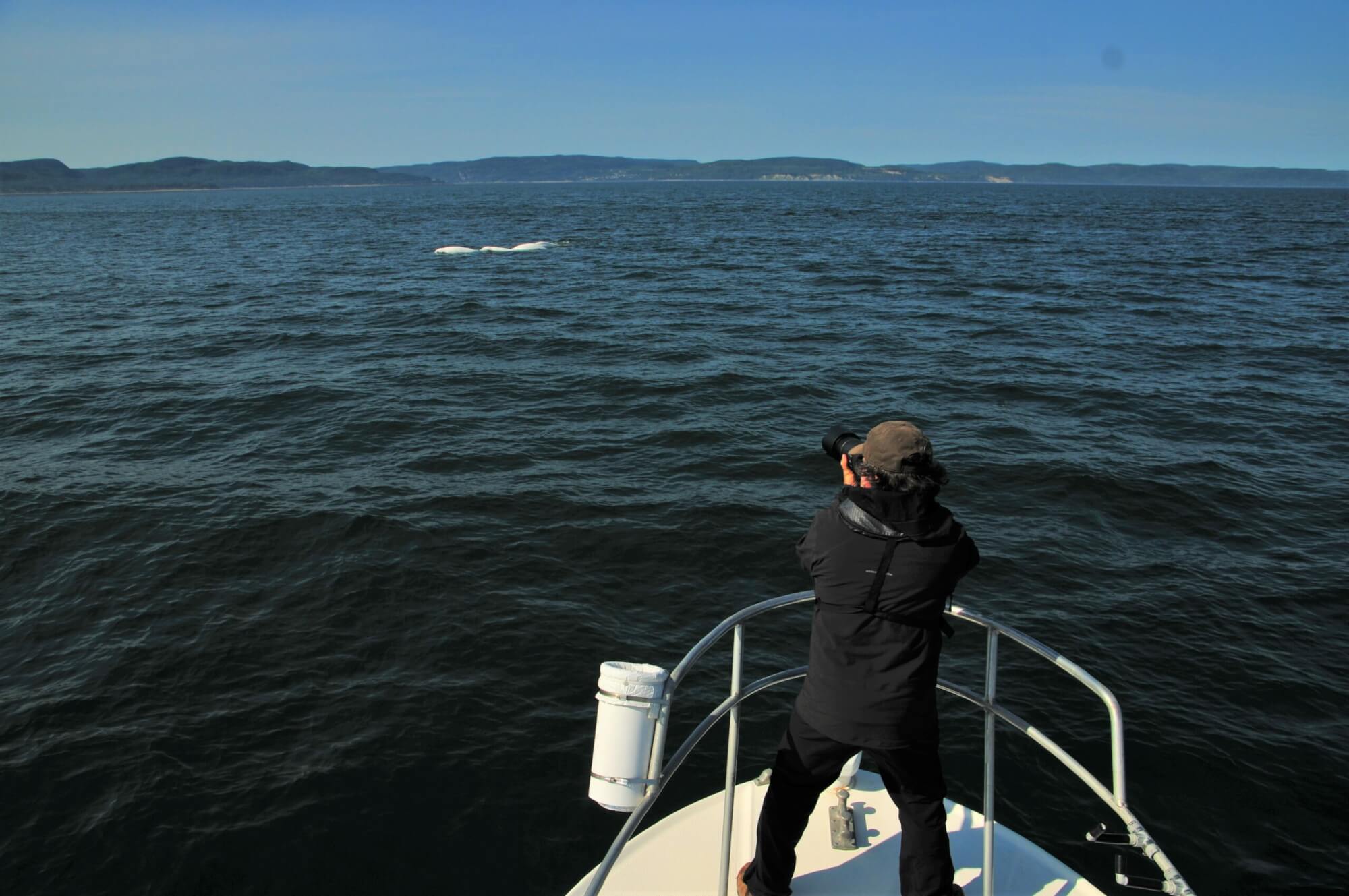A favourite subject for some but dreaded by others, math can sometimes be applied in unusual ways. As part of Science Literacy Week 2022, which took place from September 19 to 25 with mathematics as its central theme, one might ask oneself how this science can be used in the study of whales.
Of course, researchers studying whales use math in all of their research projects, but even more so in the one discussed below. The length of a whale, once measured exclusively if an animal was stranded or killed for scientific purposes, , can now be calculated while the animal is alive and in its natural environment thanks to a technique called photogrammetry. This method can be used to take measurements of whales, which may serve as an indicator of their general state of health.
A high-flying project
GREMM’s photogrammetry project (article in French) was launched in 2018. The aim of this undertaking is to observe whether belugas – an endangered species – are in good physical condition or rather on the thin sides. Data are collected at the beginning, middle and end of summer to determine how the belugas’ energy reserves have evolved over this period. Results are also compared over a span of several years.
Another new project has recently been launched to study the female belugas that return every year to Baie Sainte-Marguerite in Fjord-du-Saguenay National Park as well as Cacouna. These cows are essential to the survival of their species, and this project makes it possible to monitor the aforementioned health indicator, according to GREMM project manager Alexandre Bernier-Graveline.
One step at a time
Photogrammetry involves taking videos using a drone and using them to calculate measurements (total length, amongst others) of the whales observed. This method may also be used to determine whether females are gestating as well as to store data on the physical condition and energy reserves of these pregnant females.
YouTube video illustrating a drone flight in which data are collected for photogrammetric measurements. Images are extracted from videos taken by the drone’s camera.
Trigonometry, a basic concept of mathematics, explores the relationships between the lengths and angles of triangles. The first measurement obtained comes from a rangefinder that is fixed to the drone. The rangefinder emits several laser beams per second, which will then bounce back to a sensor located on the device. The time it takes for the light beam to return to the sensor is then converted to a distance (between the camera and the centre of the image).
Another important element is the use of a “control”: a black and white piece of cardboard placed on the deck of the research boat. It is an object of known size that allows researchers to verify that the equipment they are using is accurate.
Images from the video footage are then extracted to obtain the easiest image to measure, i.e. a beluga at the water surface and arched as little as possible. Lines are then drawn on the image using a software program. The distance from the blowhole to the narrowest part of the peduncle (which represents about 90% of a beluga’s total length) is measured, followed by multiple girth measurements. The reason for this first partial measurement is simple: “When belugas swim, their heads plunge back into the water very quickly and their tails are very low, which makes it difficult to get an image of a beluga showing its head, body and caudal fin all at the same level,” explains Alexandre Bernier-Graveline. The total length from the tip of the head to the tip of the caudal fin is only measured if the beluga is perfectly positioned, i.e. completely flat.
The software calculates the beluga’s measurements from the number of pixels separating a Point A from a Point B. This number is then converted into an actual distance using several variables, including the distance between the drone and the beluga indicated by the rangefinder.
Juggling with the data
Another branch of mathematics that is used in these studies is statistics. This is an important step in research, as it allows data to be analyzed and interpreted. Without statistics, it would be very difficult to rigorously compare the myriad of data collected every year.
Accounting for limitations
Like any science, photogrammetry has limitations and sources of error. The equipment used also has a limited degree of accuracy. It is therefore important to use such equipment appropriately, and to compensate for these inaccuracies if necessary in order to obtain reliable data. For example, the rangefinder must be attached to a suspension in order to cushion any sudden movements of the drone.
Additionally, the presence of waves and eddies in the water are taken into account when analyzing the images, as they can make it more difficult to place the points around the beluga. A number of other parameters must be taken into consideration in order to ensure the greatest scientific rigour when measurements between several belugas are being compared. To achieve this, a quality rating is assigned to each photo that takes into account the presence of waves or eddies that can render measurement-taking more difficult as well as the posture of the beluga in the image. The basic premise is that each beluga must have pierced the water surface and be as straight as possible in order to obtain suitable measurements.
Whale researchers leverage their math skills to better understand whales, which remain mysterious mammals. Indeed, research programs combining various scientific disciplines lead to new discoveries, which ultimately helps better protect these magnificent creatures.
Trigonometry, algebra, geometry… Math concepts learned at school can prove useful in a number of fields of study, and sometimes in unusual ways. We must therefore embrace this science that plays such an important role in our day-to-day lives!









